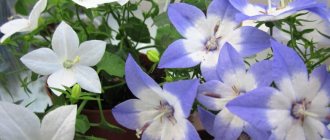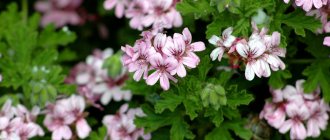Home » Flowers and plants » Flowers » Perennial flowers
Vladimir 03/19/2020
5708 Views
The representative legume in the flower bed is lupine; this unpretentious flower will delight the eye with bright colors in the background of the common flower bed. It also looks great in single plantings and is often used to create a piece of wild nature in a garden plot. Planting and caring for it will not require much effort and time; it came to us from the Mediterranean; varieties growing in North America are known. Africa, Europe and Asia.
Characteristics of the species
Many people consider lupine to be a wild plant. Indeed, its distribution is extensive, lupine is often found growing in large patches on uncultivated soils, low slopes, meadows and non-agricultural lands.
These features make gardeners sometimes disdain lupine, underestimating its obvious beneficial qualities.
Lupine perennial
Lupine is a plant of the legume family, has a well-branched tap root system, a stable thick stem, on which small bright flowers are located around the circumference.
Depending on the species, lupine can be an annual or perennial plant. For example, white narrow-leaved lupine is an annual, while blue color and a variegated corolla are often characteristics of perennial lupine. Represented by shrubs and subshrubs.
Botanical description
The root system of lupins is taprooted, sometimes going 2 meters deep. The roots are covered with small swellings that absorb nitrogen from the air and enrich the soil under the plant with it. The stems are woody or herbaceous, the branches are creeping, protruding or erect. Lupine leaves are alternate, on long petioles, palmately compound, connected to the stem by a leaf cushion with a long stipule. An inflorescence is an apical raceme on which a large number of flowers are arranged whorled, semi-whorled or alternate. The size of the brush in some species reaches one meter, the color of the flowers is varied - yellow, white, red, pink, cream and purple lupins, as well as all shades of purple.
Lupine seeds of different species differ in shape, size, and color. Lupine beans of Mediterranean species are larger than American ones. When drying, the beans crack and scatter seeds around them - very small grains of lupine. Lupine not only decorates flower beds, it is also grown as green manure: lupine stems and leaves rotted in the ground become an excellent fertilizer. In addition, fodder lupine is grown.
Lupine and his story
Metaphorically, lupine is sometimes called "wolf bean". This is a play on words reflecting the Latin origin of this name, because lupine in Latin is “Lupus” and is translated as “wolf”.
There is an ancient legend according to which a special witchcraft infusion was made from lupine flowers that could turn a person into a wolf. But more often this unusual name of the plant is explained by its “wolf-like” endurance, ability to overcome unfavorable environmental conditions, and strength.
Metaphorically, lupine is sometimes called "wolf bean"
People relatively recently began to specifically cultivate this flower; in ancient times it was practically not cultivated, but wild species were used.
In 1911, the English breeder J. Russell, through repeated cross-pollination of annual and perennial lupine species, developed a new plant species, which was characterized by a varied color of the inflorescence, the presence of several shades of flowers of one corolla, or a two-color flower color. Such hybrids still bear his name - Russell's lupins, and delight gardeners with their bright aesthetic appearance.
Lupine: combination with other plants
Lupine looks good in mixed plantings with other plants, so it is often used in landscape design. It is best to plant it in the middle of the flower garden: medium-sized plants planted in front of the lupine will effectively complement and emphasize its beauty, as well as protect it from the wind and prevent it from growing excessively. Goes well with lupine
- hosts;
- irises;
- daylilies;
- phlox;
- delphiniums;
- nivyaniki.
Lupine with other plants
A prerequisite for good growth and creating beautiful and harmonious compositions of lupins with other plants is the observance of several rules:
- Select plants with similar requirements for soil, moisture and light as lupine companions.
- Plants with a short flowering period are inappropriate.
- It is necessary to take into account the timing of flowering and the height of the plants.
- Choose plants with a contrasting inflorescence shape to lupine.
Lupine distribution area
Lupine grows on the African continent and the Mediterranean lands. It is in these latitudes that you can find huge fields of colorful lupins; there are up to 12 species of this plant.
Lupine is also found in North America, Canada, Mexico and Chile. In these areas you can see cultivated lupine.
Lupine also grows in central Russia
Historically, the cultivation of lupine took place here back in the 7th century. BC. The ancient Incas used lupine flowers and seeds for medicinal and domestic purposes.
Lupine also grows in central Russia, but here it is represented mainly by annual species; white lupine is common. This type of lupine is inconspicuous in comparison with its foreign neighbors; due to the low growth of the stem and small flowers of the usual white color, it does not catch the eye, and is even often confused with milkweed.
Varieties
As already mentioned, there are about 200 subspecies of lupine in the world, but only 10 of them are cultivated. Nowadays, many breeders are working on developing new colors that will differ significantly from existing ones.
Lupine field
In multi-layer plantings, species of standard sizes are used; they look great from a distance and do not get lost among other plants. Most often, the trunks reach a height of up to 1 m, but this largely depends on the soil.
It is best to select plants so that they do not have sharp dividing lines; the rows should smoothly transition into one another. Then your flowerbed will look like a flower bedspread.
There are also dwarf varieties ; they are planted near borders or to separate one part of the garden or flower bed from another. Border lupine reaches a height of no more than 20 cm and comes in many different colors. The methods for growing flowers are completely identical to those for growing other species.
Neighborhood in a flower bed is important; you should carefully select your lupine neighbors; the surrounding flowers should not be higher than the standard.
Lupine gets along well with:
- irises
- daylily
- hosts
- delphiniums
- phlox
- nivyaniki
These plants will not allow the rhizome to grow, and the nitrogen released by the plant will provide enough vitality to its neighbors. Near lupine, all the listed varieties of flowers will be especially bright.
Next, we will get acquainted with the most popular species that can most often be found in flower beds and gardens:
Roussel
Lupine Roussel This variety is classified as a perennial; the seeds are usually sold in specialty stores as a mixture. The collection includes stamps with different brush colors; they can be yellow, white, carmine, pink, blue.
The standard is characterized as follows:
- erect plant with a powerful trunk
- reaches a height of 1-1.3 m
- each brush is about 30-40 cm
- Grows best in sunny areas, tolerates partial shade
Propagated by seeds, sown in open ground in early spring or before winter. The variety does not require special care; weeding, loosening the soil and periodic watering during drought will be sufficient. For the winter, the trunk must be pruned, even though the variety is considered frost-resistant, but covering it or mulching it won’t hurt. Lupine Roussel will tolerate short droughts well, but during the flowering period it is better to increase watering a little, then the tassels will be brighter and will please the eye a little longer.
A distinctive feature of the variety is that the brushes can be used for cutting, this stimulates the re-blooming of the trunk in July-August. The plant looks great in group plantings; single specimens are also good. Roussel is considered one of the most nitrogen-containing varieties of garden lupine.
Russell's Red Flame
Russell's Red Flame A perennial with bright, carmine-red tassels that looks great against a hedge. Excellent for group plantings, it will become an excellent distant background for the rest of the flowers of the multi-layered flower bed. This variety will create a spectacular landscape and solo, scarlet brushes look great on any site, and the green foliage will only favorably emphasize the richness of the color of the flowers.
The plant is sown according to the generally accepted rules for lupins; if the work is carried out correctly, flowering begins in late May-early June and lasts about a month. Repeat flowering is possible if the cutting rules are followed.
An adult standard has the following characteristics:
- plant height up to 1 meter
- flowers collected in a brush occupy about 45 cm on the stem
- The brush itself is quite dense, has many colors
- flowers are medium, up to 2 cm each
- leaves are large, finger-shaped
A distinctive feature of the variety is the special fragrant nature of the flowers; their aroma is delicate but persistent, especially spreading in the evenings.
Propagation is best done by seeds; cuttings may not always give the expected result. Seeds purchased in specialized stores will have a high percentage of germination and always guarantee excellent results in matching the color of the brush.
Governor
Governer This type of lupine has become the basis for the development of many varieties and hybrids for the garden. The resulting stems are distinguished by large flowers, and the brush in which they are collected is denser. Governor is otherwise called multileaf, since its stem is covered with many large leaves.
Govner is classified as a frost-resistant species of lupine; it is used for growing in multi-layered flower beds and back-ground edgings.
The general characteristics of the trunk are as follows:
- an adult plant reaches a maximum height of 1.4 m;
- refers to perennials;
- the inflorescence raceme can reach 45 cm;
- the flowers are large, tightly pressed to each other;
- The color of the flowers is blue-white, bright;
- The standard blooms for 3-4 weeks depending on the soil and watering;
- if the brushes are trimmed, re-blooming is possible in August;
- develops better on light soils;
- tolerates sunny areas well, but does not mind partial shade;
- the leaves are large, with slight pubescence on the underside, and have a bright green color.
The brushes look great in prefabricated bouquets, but they won’t last long. Governer loves to solo, but it’s better to admire him in a flowerbed. The species is usually propagated by seeds, but cuttings also give good results.
Chatelaine
Lupine Chatelaine The perennial with the most interesting color is the Chatelain species; the standard will also differ from its relatives in the height of the adult plant. Most often it is used in the middle line of multi-layer ridges. Like all lupins, it is not picky about soils, but it will develop better on light, loose soils, without stagnant water.
Sowing in open ground is carried out in accordance with all the rules and recommendations for this variety, seedlings appear under proper conditions in a month, flowering will not occur earlier than the second year of life.
Chatelaine has the following characteristics:
- the height of an adult plant reaches a maximum of 90 cm
- finger-shaped leaves on high stalks are alternately located along the stem
- the brush can reach 35 cm
- the flowers have a pleasant pink and white color
- each flower is medium size
- weak aroma was noted during flowering
Flowering occurs profusely in June-July; when the brush is cut off, flower stalks may reappear. Some gardeners grow this species as a low hedge that divides the garden into sections.
The secret to growing is to maintain a distance between bushes; it should be at least 20 cm.
Russell mix
Russell mix The perennial Russell has many variegated colors of brushes; most often it is sold in prefabricated mixes of various colors. Cultivation is standard; the species is distinguished from others by its high survival rates even in the harshest natural conditions. Lupine of this species will easily tolerate drought, with proper shelter it will overwinter well and will delight you with lush flowering in May.
The best places for growing will be sunny areas of the garden, but partial shade will not affect the trunk. Slightly alkaline and slightly acidic loams will allow the plant to fully show its beauty.
Russell's indicators are:
- the height of an adult trunk is about 50-70 cm
- the brush is quite large, can reach 35 cm
- flowers have a variety of colors, the most common are pink, purple, blue colors
- the flower is of medium size, fragrant
The view is not suitable for cutting; it is best to admire it in its natural environment. In flowerbeds it is better to place them in the middle rows; the low height facilitates use in flower beds.
A special feature of the species is the splendor of each cluster, so there should be enough space between plants when planting.
Excitement
Azart One of the most spectacular types of lupine is called Azart, its flowers are simply magnificent. There are no particular difficulties in sowing and further care, everything is according to the standard scenario. A feature of the species is its variegation and splendor of the brush with flowers. Azart is characterized by:
- the plant can reach 1 m in height
- a brush with flowers takes up about 45 cm
- each flower is medium in size, in rare cases can reach 4 cm
- The main use of the trunk is in multi-layered flower beds and ridges in the background
- The brushes are not suitable for cutting, they will not be able to please you with freshness for a long time, they will quickly begin to fade
Often the species is used near a hedge or to create a colorful carpet in one part of the garden.
The minaret is undersized
Low-growing minaret A low-growing perennial of this species looks great as a border plant; it is often used specifically for dividing areas of the garden or flower beds. The minaret will give preference to fertile soils in areas well lit by the sun. Propagation by seeds is preferable, but separating the bud along with the root collar has also worked well.
The variety looks great cut and lasts quite a long time in vases. Cultivation is carried out through seedlings or direct sowing in heated soil. Sowing seeds can be done in early April or before winter. Cutting off the inflorescences will stimulate the plant to bloom again.
It’s not difficult to recognize the low-growing Minaret:
- the height of an adult plant does not exceed half a meter
- flower brush can reach 25 cm
- flowering continues for more than a month
- leaves are green, finger-shaped on the petiole, large
- It is difficult to tolerate sudden changes in temperature, so when growing it is worth taking into account weather conditions
In order for the trunk to grow and develop successfully, the soil should be regularly loosened and weeds removed; among fertilizers, preference is given to superphosphate.
Rhapsody
Rhapsody The variety is classified as a perennial of medium height, excellent for growing on “poor” soils of the site. It will withstand winter cold in shelter; summer drought is also not terrible. But stagnation of water or flooding in the spring can destroy the trunk. Flowering is observed in the second year of life; the flowers have a variety of variegated colors.
The general characteristics are:
- perennial grows up to a maximum of a meter
- pyramid-shaped brush has a length of up to 50 cm
- the flowers are large, each up to 3 cm
- the inflorescence is dense, the flowers are close to each other
- great for cutting, continues to live and smell fragrant in water
- leaves are large, emerald green
The variety is used in the first year for landscaping; the voluminous balls will delight the eye with lush greenery. In the second year of life, the plant will catch your eye with variegated clusters of flowers of various colors.
tree-like
Tree lupine is a perennial that differs from other varieties and species by its powerful trunk with some semblance of bark. The height of the trunk can reach 1.5 meters; under proper conditions, two-meter plants can be found. The flowering period begins in the second year after sowing the seeds and lasts a little more than a month. Usually occurs in July-August, the clusters are large, fragrant, flowers can reach 5 cm.
This species does not grow in the middle zone; even with shelter and mulching, it often freezes completely . The southern regions are excellent for growing tree lupine.
Some gardeners plant several tree-like lupins with different colors on their plot at once; they look very impressive during the flowering period, but the leaves are no less decorative. Lush greenery will transform any garden.
Lupine and its growth conditions
Lupine is a very sun-loving plant that will tolerate direct sunlight rather than prolonged partial shade. For this reason, it is highly not recommended to plant lupine in shady places.
This may not lead to its fading, but it will significantly reduce its decorative effect, because Due to the lack of the necessary period of photosynthesis, lupine flowers tend to stretch out in the stem and lose the original brightness of the inflorescence.
Lupine is not picky about the soil and can grow under almost any conditions, being capable of independently fertilizing the soil. But lupine does not tolerate heavy and overly moist soils.
Lupine is not picky about the soil and can grow in almost any conditions
Such a substrate can contribute to rotting of the root system and the development of fungal diseases of the plant. For normal growth and reproduction, this plant also requires liming.
The most cold-resistant is the perennial lupine, which is considered the most hardy and unpretentious of all the variety of species. Perennials respond well to phosphorus-potassium fertilizers, but can easily survive their complete absence.
Growing from seeds
The main method of propagating lupins is the seedling method, although they can also be propagated by cuttings. Growing them for seedlings is relatively simple and within the capabilities of a novice gardener. First, you need to decide on the sowing time:
Late February – early March. This period is suitable for sowing seedlings. Since the shoots will not have to deal with the cold at home, they will grow and be ready to be transplanted into an open space within a month and a half.
Mid-April - early May is well suited for sowing directly in the open air. But, there are a couple of conditions: the area for sowing must be prepared in the fall and the snow must have melted.
From mid to late October. Sowing can also be done in the fall. The seeds do not have time to ripen before the onset of cold weather and winter quite comfortably, waiting for spring.
The soil for seedlings should be loose, and it is prepared as follows:
- Two pieces of turf.
- Two parts peat
- One part sand.
In total, a soil mixture for seedlings is made from five parts.
If this is not your first seedling and you have old dry tubers, grind them and mix with the seeds. Bacteria from old tubers become more active and begin to absorb nitrogen, which is important for the development of shoots.
Sowing
Lupine landing. Sowing order:
For sowing, it is best to choose small peat cups. When sowing in a large container, you will have to pick out the shoots and spend additional time and containers on this.
The seed hole should be no deeper than two or three centimeters. If sowing is done in a large container, then furrows are made to the same depth.
The distance between the holes is from eight to ten centimeters. The distance between rows is ten to twelve centimeters.
The germination rate of the seeds is quite high, so it is recommended to sow no more than a couple per hole. Or one in a row with increments of about 10cm.
Sprinkle with a thin layer of soil and lightly moisten with a spray bottle.
Cover containers with seedlings with film or glass to create a greenhouse effect.
Ventilate the crops regularly (at least once a day) and moisten the soil until the first shoots appear.
With the first shoots the film can be removed.
Store seedlings at room temperature in a well-lit place.
Seedling care
Lupine care. When growing it from seeds, it is worth considering that seeds often do not transmit hereditary varietal characteristics. Most often, the white color “dissipates” from the inflorescences. Violet and pink colors dominate - they are preserved from generation to generation. To obtain a specific variety, you need to grow it from special varietal seeds purchased in a specialized store.
If everything was done correctly, then by the end of spring the seedlings will have become stronger and will produce several fully formed leaves. From this moment you can transplant them into the open air. The main thing is to wait until the snow melts and the ground warms up, but also not to overexpose the shoots in the container - the roots grow quite quickly and the later the transplant is carried out, the more difficult it is to do it without damaging them.
Lupine propagation
Lupine propagation occurs by cuttings (vegetatively) or seeds. Growing lupine from seeds is popular among gardeners - owners of fairly large areas of land, while summer residents can afford to get by with cuttings into a specially prepared substrate and box.
Lupine seeds are usually planted in March - April, at a steady temperature of at least 8-10 ° C, but planting is also possible closer to winter. In the latter case, the seeds are planted after the first frost has already passed, covering them with a small layer of peat.
Seedlings are planted in late February - early March. Before this, prepare the soil in advance as follows: the substrate should be a mixture including sand, turf soil and peat in approximately equal proportions.
Lupine propagation occurs by cuttings (vegetatively) or seeds
It is also recommended to mix the seeds with crushed tubers of old plants.
This procedure will contribute to the rapid emergence of nitrogen-fixing bacteria, and therefore to high-quality growth. This is especially true for seeds of perennial lupine varieties, which are characterized by a hard shell, which requires additional growth-promoting procedures.
Transplantation into a prepared place in an open garden space is carried out after the appearance of 5–7 leaves. As you can see in the photo of lupine, the plant goes well with irises, lilies, phlox and delphiniums.
Methods of preparation and use
Traditional medicine suggests preparing aqueous and alcoholic preparations for medicinal use based on lupine. The raw materials used are the green parts of the plant, as well as its seeds and oil, which can be purchased at the pharmacy.
Tincture
For liver diseases, colds and skin inflammations, a strong lupine tincture has a good effect. They do it like this:
- 100 g of dried herb is poured into 1 liter of vodka or dry white wine;
- put away under a lid in a dark and warm place for two days;
- After the expiration date, strain.
The resulting tincture of the lupine plant is taken orally for treatment, 5 ml three times a day.
You can use lupine tincture to disinfect lesions and spot treat ulcers on the skin.
Infusion, decoction
If you have poor appetite and liver damage, you can prepare an infusion using lupine seeds. They do it like this:
- the beans of the medicinal plant are ground to flour and 10 g are measured;
- mix the raw materials with 100 ml of table vinegar;
- add three large spoons of honey;
- add 10 g of pepper and rue;
- keep the mixture covered for two hours.
The finished product from the medicinal plant is taken 15 g twice a day.
A water infusion of lupine also has a good effect on digestion. The product is made according to the following algorithm:
- pour a large spoonful of plant grains with warm water and leave for five hours to swell;
- after the period has passed, drain the liquid;
- steam the seeds with a glass of fresh hot water;
- Boil for 15 minutes over low heat.
It is necessary to take the finished product based on the plant without straining, twice a day, in a glass.
Decoctions and infusions of lupine beans stimulate the production of gastric juice and accelerate the breakdown of food
Ointment
For wounds, ulcers and abscesses, you can use a homemade ointment based on the plant. It is prepared according to the following algorithm:
- barley and lupine flour are mixed in equal quantities;
- pour boiling water over the powder in small volumes to obtain a viscous mass;
- wait until the mixture cools down a little.
We recommend reading: Eleven multiflorum (gumi): the benefits and harm of berries, photo of the bush
Warm ointment is applied to wounds and abscesses and covered with a bandage. It must be prepared again before each procedure.
Compresses with lupine flour ointment are good for dermatitis
Lupine care
Planting and caring for lupins is simple and does not require much time and effort. Here it is important to follow important but few rules.
Lupine variety
- Firstly, temperature changes are undesirable for the full growth of lupine. Yes, the “wolf” can endure sub-zero temperatures down to –8 °C, and even the first frosts, but provided that the onset of cold weather is gradual. Fluctuations from hot to cold, strong winds and excess moisture are especially destructive for this plant. Therefore, for healthy growth of lupine, you should try to exclude such factors.
- Secondly, during the first year after planting lupine, it is advisable to periodically loosen the soil, removing weeds; liming would be useful. It is not necessary to fertilize the soil.
- Thirdly, lupine does not like strong winds. This can simply break the stem of the plant. If lupine is grown in open, windy areas, a support should be tied to the plant.
Contraindications to the use of lupine
The effect of lupine on the body is not always positive. The herb contains a large number of toxic alkaloids that can cause harm. It is necessary to refuse to use the plant:
- for individual allergies;
- during pregnancy;
- during breastfeeding;
- for severe diseases of the central nervous system;
- with cirrhosis of the liver.
Lupine-based products are not offered to children and adolescents. During therapy with a medicinal plant, it is necessary to observe small dosages and take breaks in treatment. Too much use of the herb leads to damage to the liver and nervous system, and with a single overdose of lupine, nausea, diarrhea and headaches can develop.
Lupine diseases
Lupine is a strong and hardy plant. However, an excess of water and swampy soil can cause various fungal diseases. Among them: powdery mildew, white rot, rust, etc.
In such cases, of course, you need to try to normalize growth conditions and eliminate factors that give rise to the development of the fungus. First of all, this is high humidity and proximity to other plants that are already infected with the disease.
Lupine is a strong and hardy plant
In these cases, you need to reduce watering and prune the affected plants, and sometimes completely remove them with their root system. If a lupine is infected with rot, usually only the above-ground part is cut off without affecting the root system.
It is believed that lupine is a green manure and is able to defeat the disease on its own if external oppressive factors are excluded.
To prevent the development of putrefactive processes, it would be useful to periodically water lupine with a solution of potassium permanganate in a ratio of 1:10 throughout the course of the disease.
Diseases and pests
Lupine is one of the hardiest plants in gardens and flower beds; it can survive perfectly well without fertilizing and watering
He is practically not afraid of diseases and pests. But sometimes the plant can still be exposed to certain factors.
Most often, lupine suffers from:
- aphids
- weevil
- germ fly larvae
These parasites simply destroy the inflorescence; the plant does not form seeds, which means it has nothing to reproduce with. The only way to fight them is chemically; specialized stores will be the best help here.
Powdery mildew and white rot can also spoil the appearance of boles ; flower beds on marshy soils are especially susceptible to these diseases. Fungi live best there; they have everything they need for their development. It is unlikely that it will be possible to completely eliminate the disease in such an area; it is more effective to simply remove the diseased plants. To avoid such radical methods, it is worth regularly carrying out prevention; for this, plants are sprayed with a weak solution of potassium permanganate or fungicides are used.
If many plants are sick with powdery mildew or white rot, remove them from the site. After this, add lime to the ground and dig up the affected area several times.
In addition, sometimes the leaves of lupine bushes turn yellow, this is also not the norm and can destroy the trunk.
The main reasons may be:
- excess organic matter in the soil
- soil alkalinity
- lack of moisture
To bring the plant back to normal, it is worth caring for it more carefully, perhaps liming the soil and increasing watering.
The standard of shelter in winter is also important ; a large amount of covering material can play a cruel joke. In warm winters, harmful bacteria can become active in leaves, sawdust, or simply under the film, which will subsequently even lead to the death of the trunk. That is why the prevention of fungal diseases should be carried out in early spring, as soon as the lupine is opened after wintering, and in early autumn, before the plant is wrapped before wintering.
Useful properties of lupine
It is a well-known fact that lupine is a green manure plant that is able to independently fertilize the soil, making it suitable not only for its own full growth, but also for growing other crops.
This is possible due to the presence of special elements in the roots of lupine, which, even when decomposing, fight pests and improve the quality of the soil.
Lupine can also grow in poor acidic soils, enriching the soil with essential elements. It is with this property that the endurance and durability of this plant species is associated.
Several decades ago, an experiment was carried out: in an area where lupine flowers had been growing for several years, wheat and potato crops were planted. In the fall, a harvest was obtained that was 2 times higher than the yield of the same year.
Lupine can fertilize the soil on its own
Moreover, in the neighboring plot, where lupine did not grow before planting wheat and potatoes, the harvest was much smaller. Those. we can conclude that lupine has a very beneficial effect on the composition of the soil, and even the remains of its root system can contribute to the growth of a healthy crop of cultivated plants.
In addition, lupine roots contain special alkaloid substances. These are natural analogues of ethyl alcohol that inhibit the growth of weeds and bacteria on the site. It is not without reason that many European gardeners and farmers consider lupine an excellent natural soil ameliorator.
How to get lush blooming lupins
of fasciation can be observed in lupine . This term refers to the displaced, thickened arrangement of leaves. Typically, a lupine leaf has 5-6 lobes, and in a plant with a fasciated stem this number can be 2-3 times larger. Such specimens also have more leaves in the rosette and the inflorescences are more lush due to the denser arrangement of flowers in them. Flowering stems, including lateral ones, can branch.
Fasciation is a fickle phenomenon; it occurs when the plant is fed abundantly . New rosettes are formed from new buds. In order for leaves with a large number of lobes to form in them, subsequently fasciated flower stems, lupins need to be well fed and, in dry weather, sufficient watering must be provided.
Knowing this feature, already at the stage of growing seedlings, you can select plants with leaves with ten or more lobes . They will subsequently produce plants with fasciated stems, i.e. with more luxuriant flowering.
If such selection is carried out over 2-3 generations of plants, it is possible to develop very decorative forms with an increased number of leaves in rosettes and lush inflorescences and branching flower stems.
Growing lupine for decorative purposes
For reasons that are still unclear, lupine is not very common among domestic gardeners and summer residents, which cannot be said about foreign agronomists.
American and European gardeners and farmers have long loved this plant for its brightness, unpretentiousness and feeding and fertilizing properties.
Perhaps this is due to the fact that lupine still prefers Mediterranean, African and North American climates, where it sometimes grows in vast fields of multicolored plants.
In the CIS countries, lupine can be found much less frequently and not in such immense quantities; its variety of colors and shapes is much more modest, which is what formed the opinion of domestic summer residents about lupine as a wild, useless weed.
However, just look at the photo of lupine flowers, and doubts about the decorative nature of this plant simply cannot arise!
These are bright and noticeable flowers that get along well with all types of crops, are easy to grow and do not require special additional care.
Use in cooking
For culinary purposes, mainly flour obtained from lupine seeds is used. Despite its numerous valuable properties, it does not impair the taste of products, nor does it affect their smell or consistency. The plant contains many amino acids and plant fiber, which further increases the value of flour prepared from it. Bakery products made using lupine grains can be stored for up to a week.
The plant in Japan and other Asian countries is added to soy sauce and tofu. In Europe, you can find lupine in diet ice cream - the delicacy is low in calories and at the same time very soft and pleasant in consistency. In South American countries, plant beans are consumed fried. They are no less popular than potatoes and corn.
A little about fertilizer for lupine
You should start feeding this plant in the spring of the second year after it is planted in the soil. For this purpose, fertilizers rich in minerals without the presence of nitrogen are used.
For one square meter you will need approximately 20 grams of superphosphate, as well as 5 grams of calcium chloride. After this, fertilizing will be required during all subsequent periods of spring until the plant dies.











